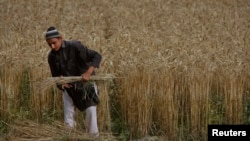Five years ago, realizing that the global economic recession and rising food prices were forcing more and more people into food insecurity, President Barack Obama committed $3.5 billion over a 3-year period to a new global initiative that would focus on reducing hunger, undernutrition and poverty. Less than a year later, in May 2010, the Feed the Future Initiative was born.
Under the leadership of the U.S. Agency for International Development, or USAID, Feed the Future focuses on smallholder farmers, particularly women. That is because growth in the agricultural sector is at least twice as effective in reducing poverty as growth in other sectors.
Thus, USAID partners with governments, civil society, the private sector and donor organizations to tailor Feed the Future programs to reflect local priorities. Working in 19 focus countries in Africa, Asia, Latin America and the Caribbean, Feed the Future has leveraged more than $18.5 billion in investments, introduced affordable new technologies to increase agricultural production and manage the risks of a changing climate, and introduced nutrient-packed foods to millions of mothers and children around the world.
In early May, USAID released the 2013 Feed the Future Progress Report, which indicates that the program has been phenomenally successful. Last year, the initiative helped nearly 7 million farmers and food producers used new technologies and management practices on about 9.9 million acres of land. It has reached more than 12.5 million children with nutrition interventions that can help them thrive, thus affording them a chance at a better future.
So, for example, 3.3 million smallholder farmers in Bangladesh increased their rice yields by 20 percent by using improved seed, fertilizer and better farm management practices. In Senegal, farmers now produce more rice, enough to feed over 400,000 of their fellow citizens for one year. And in Honduras, 4,300 families have advanced well above the 1 and a quarter dollar-per-day poverty line, in part by increasing horticulture sales by 125 percent.
In his 2009 inaugural address, President Obama said, "To the people of poor nations, we pledge to work alongside you to make your farms flourish and let clean waters flow; to nourish starved bodies and feed hungry minds. And to those nations like ours that enjoy relative plenty, we say we can no longer afford indifference to suffering outside our borders; nor can we consume the world's resources without regard to effect. For the world has changed, and we must change with it."
Under the leadership of the U.S. Agency for International Development, or USAID, Feed the Future focuses on smallholder farmers, particularly women. That is because growth in the agricultural sector is at least twice as effective in reducing poverty as growth in other sectors.
Thus, USAID partners with governments, civil society, the private sector and donor organizations to tailor Feed the Future programs to reflect local priorities. Working in 19 focus countries in Africa, Asia, Latin America and the Caribbean, Feed the Future has leveraged more than $18.5 billion in investments, introduced affordable new technologies to increase agricultural production and manage the risks of a changing climate, and introduced nutrient-packed foods to millions of mothers and children around the world.
In early May, USAID released the 2013 Feed the Future Progress Report, which indicates that the program has been phenomenally successful. Last year, the initiative helped nearly 7 million farmers and food producers used new technologies and management practices on about 9.9 million acres of land. It has reached more than 12.5 million children with nutrition interventions that can help them thrive, thus affording them a chance at a better future.
So, for example, 3.3 million smallholder farmers in Bangladesh increased their rice yields by 20 percent by using improved seed, fertilizer and better farm management practices. In Senegal, farmers now produce more rice, enough to feed over 400,000 of their fellow citizens for one year. And in Honduras, 4,300 families have advanced well above the 1 and a quarter dollar-per-day poverty line, in part by increasing horticulture sales by 125 percent.
In his 2009 inaugural address, President Obama said, "To the people of poor nations, we pledge to work alongside you to make your farms flourish and let clean waters flow; to nourish starved bodies and feed hungry minds. And to those nations like ours that enjoy relative plenty, we say we can no longer afford indifference to suffering outside our borders; nor can we consume the world's resources without regard to effect. For the world has changed, and we must change with it."

















